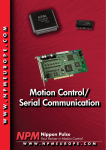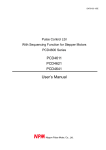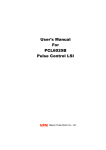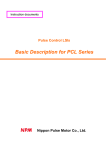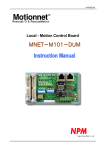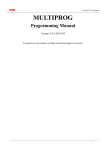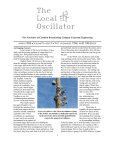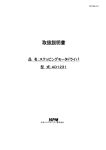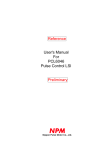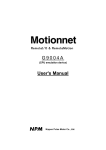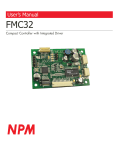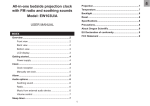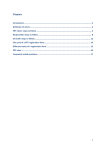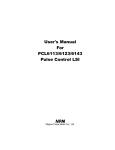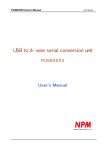Download Catalog - Electronics
Transcript
N I P P O N P U L S E . C O M Motion/Serial Communication Motion Control/ Serial Communication Nippon Pulse Your Partner in Motion Control Yo u r P a r t n e r N I P P O N P U L S E . Cn i pO M po n p u l s e . co m I n M o t i o n C o n t r o l Motion/Serial Communication A variety of Nippon Pulse motion control chips and boards are available, including programmable pulse generators, counter chips, and high-speed serial communication chips. Pages 6-11 Programmable Pulse Generators PCL60x x Series PCL61x3 Series PCL61x4 Series PCD2112 PCD46x1 Series CPU Data Command Pulse Driver Receiving commands from a CPU, a programmable pulse generator can control a stepper motor or servomotor. The programmable pulse generator receives operating parameters for operating patterns from the CPU, and subsequently sends a START command. The motor control can then be committed to the chip, thereby reducing the burden to the CPU. Since Nippon Pulse first offered them in 1985, these programmable pulse generators have evolved, thanks in part to meeting the needs of our customers. These chips are available with a wide range of variations, including ultra-high-performance versions with interpolation functions, low-cost versions for simple motion control, and miniature versions. Motor Reference Clock Encoder ±EL, ±SD, ORG Signals from Mechanical Systems Mechanical Systems Pages 12-16 High-Speed Serial Communications Chips G9000 Series These chips are designed to configure a high-speed serial communications system with less wiring. I/O control functions, motor controls and data communications functions are available. Designed with “best open field bus” in mind, these chips are also available as DIN rail-mounted boards, which can be combined with user-designed boards. Applications Factory Automation Semiconductor/Liquid Crystal Mfg. Healthcare Equipment Security & Office Automation Injection molding machine Mounter Laser processing Winding machine Dispenser X-Y stage Knitting machine Paper processing Taping machine Food processing machine Robot Packinging machine Automatic soldering machine Exposure system Membrane forming machine Etching machine Washing machine Probing machine Dicing machine Bonding machine LSI tester Handler Molding machine Appearance inspection instrument Dimension measuring instrument Liquid crystal processing Blood analyzer Liquid injector CT scanner MRI apparatus Biopsy instrument X-ray generator Trial drug processor Pre-analysis processor Electronic microscope Care & support instruments Security camera Entrance/exit checking machine Parking management machine Industrial printer Laser printer Labeling machine Card conveyor Bank ATM Sorting machine Liquid handling instrument Amusement equipment House automation equipment 2 n i p po n p ulse . com N i p p o n P u l s e Motion/Serial Communication Selection Guide PCL6046 PCL6045BL PCL6113 PCL6123 PCL6143 Y Y Y Control stepper motor PCL6114 PCL6124 PCL6144 Y PCD2112 PCD4611 PCD4621 PCD4641 G9103 G9003 Y Y Y Y Y Y Y Y Make simple 2-phase step motor drive circuit Y Y Servomotor I/F, up/down counter Y Y Servomotor, I/F, high max, output freq. Y Y Excitation sequencer function Control servomotor Y Y Y Y Control linear motor Y Y Y Y Control 1 axis w/one chip Control max. 2 axes w/one chip Y Y Y Y Y Y Y Y Y Control max. 4 axes w/one chip Y Y Y Y Y Use 8-bit CPU data bus Y Y Y Y Y Compatibility w/16-bit CPU data bus Y Y Y Y Serial CPU data bus (SPI) Y Stand alone operation w/ no CPU connected Motionnet Y Y Independent operating system mode Control 1 axis w/ Motionnet® serial communication Y Control multiple axes w/Motionnet serial communications line in combo w/ G9004A Y Y Y Y Y Y Control multiple axes w/ Motionnet® using multiple chips High cost-performance Remarks Y Y Y Y Y Y Y Y Y G9004A emulation mode Y Y Y Y Y Y Y Low unit price per axis Supply voltage 3.3V Y Compatibility of input signal w/ 5V interface Y Enable construction of smaller board Y Need up/down counter other than positioning control Y Y Y Y Y Y Y Up/Down counter Positioning control w/encoder signal Y Y Y Y Y Y Y Encoder input Origin return w/ Z-phase signal Y Y Y Y Y Y Y Origin return function Independent setting of accel/decel time Y Y Y Y Y Y Y Accel/decel rate setting Y Y Y Y Y Y Automatic setting of ramping-down point w/ accel time=decel time Automatic setting of ramping-down point w/ accel time ≠ decel time and w/ accel time = decel time Y Y Linear interpolation between 2+ axes Y Y Circular interpolation between 2 axes Y Y Small dimensions Automatic setting of ramping-down point Y Y1 Tolerant buffer Y Interpolation between remote boards through serial communication Y Automatic setting of ramping-down point Y Interpolation function/operation 1 Y Interpolation function/operation Y1 Interpolation function/operation Y1 Continuous interpolation operation Continuous interpolation w/ no cessation Y Y Y1 Linear interpolation only Y S-curve acceleration/deceleration Y Y Y Y Y Y Y S-curve acceleration/deceleration Linear accel/decel section on S-curve Y Y Y Y Y Y Y Setting S-curve section Automatic elimination of triangular drive Y Y Y Y Y Y Y FH correction function Manual pulser Y Y Y Y Y Y Y Pulser input mode Comparator function Y Y Y Y Y Y General purpose I/O port Y Y Y Y Y Y Out of step detection Y Y Y Y Continuous operation from present to the next Y Y Y Y Speed change during operation Y Y Y Y Target position change during operation Y Y Y Y Long acceleration/deceleration time Y Y Y Delicate pulse rate setting Y Y Programmed soft limit function Y Y 1 Y Y Y Y Prebuffer/preregister Y Y Overriding speed Y Y Override target position Y Y Long bit length of accel/decel registers Y Y Y Long bit length of speed register Y Y Y Y Y Interpolation function of PCL6113 and G9103 is usable when two or more units are connected. Yo u r P a r t n e r I n M o t i o n C o n t r o l n i p po n p u l s e . co m 3 Motion/Serial Communication Selection Guide PCL6046 PCL6045BL PCL6113 PCL6123 PCL6143 PCD2112 PCD4611 PCD4621 PCD4641 S-curve acceleration/deceleration Y Y Y Y Y Y S-curve section setting Y Y Y Y Y Y Triangular drive correction function Y Y Y Y Y Y Y Y (13 types) Y (13 types) Y (4 types) Y (4 types) Y (4 types) Y (13 types) Y (13 types) Y Y Y Y Limit positioning Y Y Limit escape Y Y Servomotor interface Y Y Y Encoder input (up to 4Xs multiplication possible) Y (for each axis) Y (for each axis) Origin return using encoder Z-phase signals Y (for each axis) Up/down counter (present position counter) Y (for each axis) 32-bit x 3 16-bit x 1 Automatic setting of ramping-down point Origin return at up/down counter zero (automatic zero return) Counter latch w/hardware Specifications of Programmable Pulse Generators PCL6025B PCL6045BL PCL6046 Num. of controllable axes 4 Reference Clock 19.6608 MHz (max 30 MHz) Max. Output Speed 1 # of pulse rates setting registers PCL6113 PCL6123 PCL6143 PCL6114 PCL6124 PCL6144 PCD2112 2 (PCL6025B) 4 (PCL6045/BL) 1 (PCL6113) 2 (PCL6123) 4 (PCL6143) 1 (PCL6114) 2 (PCL6124) 4 (PCL6144) 1 19.6608 MHz (max 20 MHz) 19.6608 MHz (max 30 MHz) 19.6608 MHz (max 30 MHz) 9.8304 MHz (max 20 MHz) Motionnet® PCD4611 PCD4621 PCD4641 G9103 1 (PCD4611) 2 (PCD4621) 4 (PCD4641) 1 4.9152 MHz (max 10 MHz) 80 or 40 MHz G9003 1 80 or 40 MHz 6.5 Mpps (max 10Mpps) 9.8 Mpps (max 15 Mpps) 9.8 Mpps (max 15 Mpps) 2.4 Mpps (max 5 Mpps) 2.4 Mpps (max 5 Mpps) 6.66 Mpps (max 10 Mpps) 6.66 Mpps 3 (FL, FH, FA (for correction)) 3 (FL, FH, FA (for correction)) 2 (FL, FH) 2 (FL, FH) 2 (FL, FH) 2 (FL, FH) 3 (FL, FH, FA [for correction]) 3 (FL, FH, FA [for correction]) # of pulse rating setting steps 1 to 65,535 (16-bit) 1 to 65,535 (16-bit) 1 to 16, 383 (14-bit) 1 to 65,535 (16bits) 1 to 8,191 (13-bit) 1 to 8,191 (13-bit) 1 to 100,000 (17-bit) 1 to 100,000 (17-bit) Pulse rating multiplication setting range 0.1x to 152.5x 0.1x to 100x 0.3x to 600x 0.3x to 600x 0.5x to 300x 1x to 300x 0.1x to 66.6x 0.1 to 66.6x Acceleration rate setting range 1 to 65,535 (16-bit) 1 to 65,535 (16-bit) 1 to 16,383 (14-bit) 1 to 65,535 (16bits) 1 to 65,535 (16-bit) Deceleration rate setting range 1 to 65,535 (16-bit) 1 to 65,535 (16-bit) 1 to 16,383 (14-bit) 1 to 65,535 (16bits) 1 to 65,535 (16-bit) # of positioning pulse setting range -2,147,483648 to +2,147,483,647 (32-bit) -134,217,728 to +134, 217, 727 (28-bit) -134,217,728 to +134, 217, 727 (28-bit) -2,147,483,648 to +2,147, 483, 647 (32-bit) 0 to 268,435,455 (28-bit) CPU interface 8-/16-bit bus 8/16-bit bus 8/16-bit-bus 8/16 bit or SPI (can be changed) Serial bus interface (SPI) 0 to 16,777,215 (24-bit) 8-bit bus 1 to 65,535 (16-bit) 1 to 65,535 (16-bit) 1 to 65,535 (16-bit) 1 to 65,535 (16-bit) -134,217,728 to +134,217,727 (28-bit) -134,217,728 to +134,217,727 (28-bit) Interface for communication w/G9000 Interface for communication w/G9000 Ramping-down point setting 0 to 16,777,215 (24-bit) 0 to 16,777,215 (24-bit) 0 to 16,777,215 (24-bit) 0 to 16,777,215 (24-bit) 0 to 16,777,215 (24-bit) 0 to 16,777,215 (24-bit) 0 to 16,777,215 (24-bit) 0 to 16,777,215 (24-bit) Package 208-pin BGA 128-pin QFP (PCL6025B) 176-pin QFP (PCL6045BL) 80-pin QFP (PCL6113) 128-pin QFP (PCL6123) 176-pin QFP (PCL6143) 80-pin QFP (PCL6114) 128-pin QFP (PCL6124) 176-pin QFP (PCL6144) 48-pin QFP 48-pin QFP (PCD4611) 64-pin QFP (PCD4621) 100-pin QFP (PCD4641) 80-pin QFP 80-pin QFP 24 x 24 (PCL6045BL) 20 x 14 (PCL6025B) 12 x 12 (PCL6113) 20 x 14 (PCL6123) 24 x 24 (PCL6143) 12 x 12 (PCL6114) 14 x 14 (PCL6124) 24 x 24 (PCL6144) 10 x 10 7 x 7 (PCD4611) 10 x 10 (PCD4621) 14 x 14 (PCD4641) 12 x 12 +5V±10% and +3.3V±10% (6025B) +3.3V±10% (6045BL) +3.3V±10% +3.3V±10% +3.3V±10% +3.3V±10% +3.3V±10% External dimension (mm) 12 x 12 Supply voltage +3.3V±10% Origin return Origin search, origin escape 6.5 Mpps (max 10 Mpps) 2 to 65,535 (16bit) (Common to accel/decel) Motion/Serial Communication Selection Guide 12 x 12 Comparator External mechanical output Interrupt signal output Standard maximum output rate is the rate available with the reference clock input and the maximum rate in parenthesis, with the maximum reference clock input. For PCD4600 series, the stated maximum output pulse rate is a practical value and output at higher pulse rate is possible by increasing the multiplication factor. 3 For PCD4600 series, the stated multiplication factors are a practical range and it is possible to set the multiplication factor higher than 50x. 1 2 Notes on Specifications Y Y Y Y Y Y Y Y Y (for each axis) Y (for each axis) Y Y Y Y (for each axis) Y (for each axis) Y (for each axis) Y Y Y Y (for each axis) 28-bit x 3 16-bit x 1 Y (for each axis) 28-bit x 2 Y (for each axis) 32 bit x 2 Y 32-bit x 1 Y (24-bit [for each axis]) Y 28-bit x 2 16-bit x 1 Y 28-bit x 2 16-bit x 1 Y Y Y Y Y Y Y Y Y Y Y Y Y Y Y Y Y Y Y (for each axis) 28-bit x 3 Y (for each axis) 28-bit x 3 Y (for each axis) 32-bit x 5 Y (for each axis) 28-bit x 5 Y (for each axis) 28-bit x 2 Y (for each axis) Y (for each axis) Y (for each axis) Y (for each axis) Y Y Y Y Y (37 factors) Y (37 factors) Y (23 factors) Y (27 factors) Y Y (6 factors) Y (27 factors) Y (27 factors) Y Interrupt factor setting Y Y Y Y Y Interrupt status Y Y Y Y Y Y Status Y (77 types) Y (77 types) Y (44 types) Y (46 types) Y (30 types) Y (30 types) Prebuffer (preregister) for next operation Y (2 stages) Y (2 stages) Y (1 stage) Y (1 stage) Y (1 stage) Y Y Y Y Y Automatic start of next operation Y Y (16 types) Command buffer monitor Y Y Y Y Y Selection of output pulse logic Y Y Y Y Y Y Y Y Selection of output pulse mode Y Y Y Y Y Y Y Y Y Y Y Y Y (9 for each axis) Y (9 for each axis) Y (6 for each axis) Y (6 for each axis) Y (2) Y (1) Y (10) Y (10) Y (for each axis) (multiplication by 32 & division by 2048) Y (each axis) (multiplication by 32 & division by 2048) Y (each axis) (no multiplication/ division function) Y (each axis) no multiplication/ division function Y (no multiplication/division function) Y (each axis) (multiplication by 32 & division by 2048) Y (each axis) (multiplication by 32 & division by 2048) Y Y Y Excitation sequence output for 2-phase stepper motor Pulser input (External Pulse Input) Y Pulser synchronized positioning Y Y Y Y Linear interpolation Y Y Y Y Circular interpolation Y Y Continuous interpolation Y Y Y Y Y Y Y (only during linear acceleration) Y Y Y Frequency of the clock, which is programmed into the pulse generator. A frequency other than the standard can be entered, but the output pulse rate may be lower than decimal point. Maximum output pulse rate Maximum rate at which the chip can output pulses Number of pulse rate setting registers There are FL registers to which the starting pulse rate is written and FH registers to which the operating pulse rate is written. The operating pulse rate can be changed during the operation in progress by rewriting it Number of pulse rate setting steps Number of steps available for pulse rate setting. The more bits, the finer pulse rate possible Pulse rate multiplication setting range Output pulse rate is a product of the value of pulse rate register and of the multiplication setting Operating switch input terminal Y Y Acceleration rate setting range Pulse rate slope at acceleration is set. Acceleration time can be calculated from the setting value. Ring count function Y Y Pulse rate slope at deceleration is set. Deceleration time can be calculated from the setting value. Backlash correction Y Y Number of positioning pulses setting range Number of output pulses for positioning is set Programmed soft limit Y Y CPU interface Typical CPUs are stated in User’s Manual Ramping-down point setting range Starting point of deceleration for positioning is set based on the number of remaining pulses P u l s e Y Y (for each axis) 32-bit x 2 software limit only x 2 Overriding target position N i p p o n G9003 Y Y Number of axes a single chip can control n i p po n p ulse . com G9103 Y Reference clock 4 Motionnet® Y Number of controllable axes Deceleration rate setting range Y (1 type) Y Origin return w/moving amount restricted Monitor signal output terminal +3.3V±10% PCL6114 PCL6124 PCL6144 1-pulse output Idling pulse Y Y Y (0 to 7 pulses) Y (0 to 7 pulses) Y Y Output pulse width control Y Y Y Y Y Y Y (0 to 7 pulses) Y Y Y Y (0 to 7 pulses) Y (0 to 7 pulses) Y Y Simultaneous start/stop Y Y Y Y Y Y Y Y External start/stop Y Y Y Y Y Y Y Y Y Y Y (8 for each axis) Y (8 for each axis) Y (4) Y (1 for each axis) Y (8) Y (8) Y Y Y Y Y Out-of-step detection I/O port (general-purpose input/output terminal) Y Y Y (8 for each axis) Y (8 for each axis) Y Timer operation Y Y Y Y Synchronization signal output Y Y Y Y Vibration supression Y Y Yo u r P a r t n e r I n M o t i o n Y C o n t r o l Y Y Y Y Y Y Y Y Y Y Y Y n i p po n p u l s e . co m 5 Motion/Serial Communication Motion/Serial Communication Typical Acceleration/Deceleration Patterns How to Determine Output Pulse Rate Changing Pulse Output Pattern During Operation (S-Curve acceleration/deceleration) Applicable models: PCL6000, PCL6100, PCD2112, G9103, G9003 As shown below, various acceleration/deceleration patterns can be programmed. Output Pulse Rate = Pulse Rate Register Value x Multiplication Register Value The higher the pulse rate register value, the finer the output pulse rate can be set. Pulse Output Pattern Shown below is an example of S-curve acceleration/deceleration and S-curve section: Acceleration rate Deceleration rate FH pulse rate S-curve Deceleration section S-curve acceleration section Note: With PCD46x1 series, S-curve acceleration/ deceleration sections cannot be set, and the deceleration rate is the same as the acceleration rate. FL pulse rate Ramping-down point for positioning; set manually or automatically Typical Operation Profiles Preset Operation (Positioning) The chip stops generation of pulses upon outputting a preset number Immediate stop command Immediate stop command Origin Return/Homing Origin return sequence can be programmed using origin signal (ORG) ramping-down process signal (SD), end limit signal (EL) and encoder Z-phase signal. Listed below are typical origin return sequences in varied-speed operation. Immediate stop command 1 Constant-speed operation Varied-speed operation w/ S-curve acceleration/ deceleration Varied-speed operation w/ linear acceleration/ deceleration Immediate stop command Immediate stop command Constant-speed operation Immediate stop command 1. 2. Constant-speed operation Varied-speed operation w/ linear acceleration/ deceleration 3. Varied-speed operation w/ S-curve acceleration/ deceleration 4. Deceleration Stop Deceleration-stop command lets the chip decelerate the pulse output and stop upon decelerating to the starting pulse rate. Deceleration stop command 2 3 3 Immediate Stop Immediate stop command stops the chip from outputting pulses irrespective of operating status. Applicable models: PCL6000 series, PCL6100 series, PCD2112, G9103, G9003 Receiving signal from a manual pulser, the programmable pulse generator outputs to the driver, the pulse signal corresponding to the rotating amount, and speed designated by manual pulse signal. If required, the present position can be controlled using the up/down counter. To prevent the stepping motor from running out-of-step, the operating speed (output pulse rate) can be restricted. 1 2 2 3 Pulser Input/External Input Varied-speed operation w/linear acceleration/ deceleration Interface Circuit Varied-speed operation w/ S-curve acceleration/ deceleration SD signal ON starts deceleration (1), and ORG signal ON stops pulse output (3). SD signal ON starts Z-phase signal counting (2), and completion of counting stops pulse output (3). ORG signal ON starts deceleration (1), and pulse rate output stops when decelerated to the FL pulse rate (3). ORG signal ON starts deceleration and Z-phase signal counting (1), and completion of counting stops pulse output (3). PCL6000 series and G9103/G9003 provide many other origin return sequences including those using EL signal. With PCD46x1 series, only the first and third sequences are applicable. PA OUT PB DIR Manual Pulser Pulse Dir OUT Motor Mechanism Driver IC PCL Interpolation Applicable models: PCL6000 series, G9103 (circular/linear interpolation), PCL series (linear interpolation only) There are chips that provide both circular interpolation and linear interpolation functions and chips that provide only linear interpolation function. Models providing linear interpolation function enable interpolation in three dimensions. Models with circular and linear interpolation functions enable continuous circular-circular or linear-circular interpolation without cessation on the way. Deceleration stop command Circular Interpolation Varied-speed operation w/ linear acceleration/ deceleration The preset FH register value can be changed to a lower value while acceleration is in progress. 1. If the newly set value is lower than the pulse rate at the time of the change, S-curve deceleration is made to the newly set value 2. If the newly set value is equal to or higher than the pulse rate at the time of the change, S-curve acceleration is made to the newly set value. Change the preset FH register value to a higher value during acceleration in progress. 3. S-curve acceleration is made to the preset pulse rate and then to the newly set value. Change the preset FH register value during operation at the FH rate in progress. 4. If the newly set value is higher than the preset FH register value, S-curve acceleration is made to the newly set value. 5. If the newly set value is lower than the preset FH register value, S-curve deceleration is made to the newly set value. Varied-speed operation w/ S-curve acceleration/ deceleration Linear Interpolation Continuous circular-linear interpolation Overriding Target Position Applicable models: PCL6000 series, PCL6100 series, G9103, G9003 Target position can be changed during operation in progress. Triangular Drive Correction Function Applicable models: PCL60xx, PCL61xx, PCD2112, G9103, and G9003 When positioning and movement are minimal, this function automatically lowers the operating pulse rate (FH), thereby eliminating triangular drive and realizing a smooth pulse rate curve. Correction of triangular drive due to less moving amount 6 n i p po n p ulse . com N i p p o n P u l s e Change to a position beyond the preset target Yo u r Change to a position beyond the preset target P a r t n e r I n M o t i o n Change to a position before the preset target C o n t r o l n i p po n p u l s e . co m 7 Motion/Serial Communication PCL6000 Series Advanced Motion Controllers PCL6025B (2-axis) Motion/Serial Communication PCL6100 Series High Performance Servo/Stepper Controllers PCL6045BL (4-axis) PCL6123 (2-axis) PCL6113 (1-axis) PCL6046 (4-axis) PCL6143 (4-axis) Advanced functions in this series include linear/circular interpolation, overriding operating pulse rate and target position during operation, operation correction, backlash correction, suppression of vibration at cessation, programmed soft limit, direct input of operating switch, diversified origin return sequences, mechanical signal input and servomotor interface. These functions enable the user to easily configure a complicated motion control system. Because these chips have built-in preregisters (one stage), two up/down counters, per axis comparators, linear interpolation function, and servomotor interface, they can serve general motion control applications. This series is recommended for customers who need increased operational control that cannot be achieved with the PCD series. The maximum output pulse rate of 15 Mpps makes these chips compatible with high-resolution linear motors. There are also evaluation boards available that have the ability to reduce the number of development steps. Features PCL61x3 Series Features • Circular interpolation between two desired axes and linear interpolation among two to four desired axes • Linear interpolation among five or more axes is also possible by using two or more chips (three or more axes for the PCL6025B) Preregisters enable continuous interpolation, circular-to-linear-tocircular Maximum output pulse rate: 6.5 Mpps (10 Mpps with PCL6046) Built-in four up/down counters per axis • PCL6046: 32-bit x 3 and 16-bit x 1; PCL6045BL/PCL6025B: 28-bit x 3 and 16-bit x 1 • All counters can be used for various purposes since they can be latched or reset by signal input, conclusion of operation conditions, or the command Built-in five comparators per axis • PCL6046: 32-bit x 5; PCL6025B/PCL6045BL: 28-bit x 5 • Use of comparators and counters in combination enables the following operations: • Interrupt signal output and external output of comparison results • Starting by internal synchronization signal • Immediate stop of deceleration-stop • Programmed limit • Out-of-step detection • Output of synchronization signal • Ring count function Overriding operating pulse rate and target position during operation in progress • Directly accessible to registers, not through input/output buffers (PCL6046 only) • 18 major operating modes • Two-stage preregisters are built in to permit writing parameters (moving amount, starting pulse rate, operating pulse rate, acceleration rate, deceleration rate, multiplication factor, ramping-down point, operating mode, center of circular interpolation, S-curve accel/decel) for the succeeding two operations during operation in progress • • • • • 8 n i p po n p ulse . com N i p p o n • • • P u l s e Composite pulse rate in interpolated operation can be kept constant Manual pulser input terminal (with functions to multiply by 32 and to divide to 2048) Seventeen kinds of error factors and 20 kinds of event factors, any of which can initiate interrupt signal output (event factors can be selected by register) • • • • PCL6045B-mounted boards • Linear interpolation among two to four desired axes • Linear interpolation between chips is also possible Maximum output pulse rate: 15 Mpps Built-in two up/down counters per axis (28-bit) Built-in comparators per axis (28-bit) • Use of comparators and counters in combination enables the following operations: • Interrupt signal output and external output of comparison results • Ring count • Starting by internal synchronization signal Overriding operating pulse rate and target position during operation in progress • • • • Nine major operating modes One stage preregisters are built in to permit writing parameters (moving amount, starting pulse rate, operating pulse rate, acceleration rate, deceleration rate, multiplication factor, ramping-down point, operating mode center of circular interpolation, S-curve acceleration/ deceleration sections) for the next operation during operation in progress Manual pulser input terminal (with no muliplier/divider function) 23 kinds of error and event factors, any of which can initiate interrupt signal output (event factors can be selected by register) PPCI-7443 Quadraxial Motion Control Board with PCI Bus Pulse train output type; can control servomotor and stepper motor PCL6124 (2-axis) PCL6114 (1-axis) PCL6144 (4-axis) This Series has all the same features as the PCL61x3 series, but with an available SPI interface in addition to 8-bit and 16-bit data buses, among other improvements. PCL61x4 Series Features NPMC6045A-4104 Quadraxial Motion Control Board with PC/104 Bus Pulse train output type; can control servomotor and stepping motor • • • • • • In addition to 8-bit and 16-bit data buses, this series has an available SPI interface Built-in two up/down counters per axis (32-bit) Built-in comparators per axis (32-bit) Extended registers for position, speed, acceleration and deceleration Programmable software limits (similar to PCL6000 series) Four more event factors to initiate interrupt signal output. Selectable by internal register. Yo u r P a r t n e r I n M o t i o n C o n t r o l n i p po n p u l s e . co m 9 Motion/Serial Communication Motion/Serial Communication PCD4600 Series PCD2112 Economical Stepper Controllers Miniature Servo/Stepper Controller with SPI The first of its kind, this miniature package (mold measuring only 7x7mm) adopts a fourwire serial bus that enables downsizing of the board. It can output two-phase stepping motor excitation sequence and is equipped with a servomotor interface. The PCD2112 can control both stepper motors and servomotors. PCD2112 • • • • PCD4611 (1-axis) FMC32 Control Board Features Connection to CPU via four-wire serial bus • Usable with CPU, which is not provided with external bus terminal • General-purpose I/O terminals can effectively be used with CPU having multipurpose pins for external bus Optimized control parameter arrangement and block transfer • This enables reduction of transfer time to minimum Independent system mode for operation with no CPU • Operation with no CPU is made possible by externally connecting EEPROM in which up to 32 operating patterns are written • Maximum output pulse rate: 5Mpps (with reference clock 20MHz) • Pulse output mode: Selectable from 12 types of pulse signal outputs and two-phase stepping motor excitation sequence • 32-bit up/down counter built in • 11 major operating modes • Manual pulser input terminal (with no multiplier/divider function) • 12 factors are available to initiate interrupt signal output (event factors can be selected by register) Suitable for customers who want to: • Intelligently control the motor with a CPU with fewer pins • Make the motor control board smaller • Operate the chip like a stand-alone unit without a CPU connected at the time of operation • Enjoy more functions than provided by conventional PCD series PCD4621 (2-axis) The PCD4600 series chips are low-cost, programmable pulse generators equipped with an excitation sequence generator circuit to drive two-phase stepper motors. Placing a stepper motor drive IC between the PCD and each stepper motor enables the user to easily configure a multi-axial motion control system. Each model can also output a pulse train. Features • The FMC32, a compact controller with integrated driver, is equipped with a pulse control LSI PCD2112 for controlling a serial bus. Using the FMC32 board with a USB to 4-wire serial conversion unit (PUSB3503), you can design a series of execution sequence programs and write the designed execution sequence program to the board. The designed execution sequence program can be verified and confirmed on the PC. Users are able to program up to 32 motion profiles with both linear and s-curve patterns. By using control software, you can monitor the contents of all registers of the PCD2112 in real time. You can use this function to understand the PCD2112 thoroughly. A CPU is equipped with the FMC32. You can repeat the execution sequence program written to the FMC 32 automatically. If you use a motor and a driver additionally, you can confirm operation in more detail. The FMC32 board has two operational modes, the PC control mode and the standalone control mode. • • • Output pulse rate: 2.4 Mpps • Practical rate; theoretically max. 5 Mpps Linear and S-curve acceleration/deceleration Two-phase stepper motor excitation sequence circuit built-in Simultaneous start/stop • Pulse output on multiple axes within one chip or on multiple chips can be started simultaneously by the command or external signal. Pulse output on all axes can be stopped by the command, external signal, or failure on any axis. • Idling pulse output (1 to 7 pulses) • Overriding operating pulse rate during operation in progress • Four major operation modes Connection Examples 1. Send Excitation Sequence Signals to a Driver IC. Driver IC PCD4611 CPU Data D0-D7 Ø1 Ø2 Ø3 Ø4 Excitation Sequence Signal IN1 IN2 IN3 IN4 Stepper Motor 2. For any Driver IC with a Built-In Excitation Sequence Circuit, Send a Pulse Train. Driver IC PCD4611 New Serial Bus System Conventional Data Bus System PCD4641 (4-axis) CPU Data D0-D7 +P0 -P0 CS, A0, A1, RD, and WR signal lines Command Pulse CW CCW Out CPU w/ SPI Stepper Motor PCD2112 CPU Data Bus 10 n i p po n p ulse . com Conventional PCD/PCL N i p p o n P u l s e Yo u r P a r t n e r I n M o t i o n C o n t r o l n i p po n p u l s e . co m 11 Motion/Serial Communication G Series Basic Specifications of High-Speed Serial Communication Chips in G9000 Series High-Speed Serial Communication for I/O, Motion Control and CPU Emulation A G9001A G9002A Local Device I/O Center Device G9004A G9003/G9103 Local Device CPU Emulator PCL Device Pulse Generator Motionnet® is a high-speed serial communications system. Configured with Nippon Pulse’s unique G9000 series chips, the system satisfies requirements for factory automation by completely enabling remote control of input/output, motors, CPU emulators, and message communication with less wiring. In cyclic communication for input/output control, 4-byte data is constantly transferred in a maximum 15.1ms. It can be interrupted by a maximum 256-byte data in motor or device control. Communication time can be calculated by using the prescribed equation, ensuring the real-time characteristics demanded for factory automation. Motionnet® is recommended for use as a basic communications system for factory automation. These motion control chips are available as independent chips or G9000 series mounted boards (Motionnet® boards) that can be combined with user-designed boards. Name Center Device Local Device (I/O) PCL Device (Pulse Generator) Local Drive (CPU Emulator) Model G9001A G9002A G9003/G9103 G9004A -- -- Z80, 8086, 68000, H8, etc. CPU interface Z80, 8086, 68000, H8, etc. Reference clock 80 MHz (or 40 MHz) Communication speed Selected from 20, 10, 5, or 2.5 Mbps Communication protocol Nippon Pulse original Communications mode Cyclic mode for I/O ports and status communication, transient mode for data communication (half-duplex) Interface RS-485 + Pulse transformer Connection system Multidrop system Error detection method CRC12 Features • Completely controls serial communication, thus minimizing burden to CPU Cyclic transfer for I/O ports and transient transfer for data communication • Motionnet ® Connect up to 64 local devices! • • Motor Drive G9001A Stepper motor/Servomotor • • • G9002A • • • 32-bit I/O ports Input/output direction selectable by every 8 bits Tolerant buffer is used for interface, enabling it to connect to 5V using few componets CPU Emulation Mode G9004A G9004A 4-port 32-bit Input/Output LCD Controller A-D/D-A Converter G9002A PCL 6045B PCL 6045B 4-port 32-bit Input/Output Local MicroProcessor Cable length G9004A FPGA Linear/circular interpolation possible w/ PCL6000 series G9003/ G9103 G9002A G9103 G9103 • Provides the performance of 1 axis in NPM high-end multiaxial programmable PCL6000 series Tolerant buffer is used for interface, enabling it to connect to 5V using fewer components • • Enables control of remote devices by emulating CPU Enables data exchange from/to remote local devices Message Communication Mode Data buffer length 128 words 128 words 1 word for system booking 127 words for message data Data communication time 21.7ms to transfer 5 words 169.3ms to transfer 128 words Control address space 64 bytes Communication data length 1 to 128 words/frame (1 word = 16 bits) G9004A G9003/ G9103 • A maximum of 64 local devices can be connected to one serial line coming from the center device. Maximum 256 input/output control ports (2048 bits), maximum 64 motion control axes, and maximum 128 chip control devices Input/output and each device status communication time. Input/output and each device information is automatically updated in the RAM of center device by every one cyclic communication With communication rate of 20Mbps (cyclic communication 15.1ms/local device): • 1. 0.12ms w/8 local devices connected (I/O: 256 bits) • 2. 0.24ms w/16 local devices connected (I/O: 512 bits) • 3. 0.49ms w/32 local devices connected (I/O: 1024 bits) • 4. 0.97ms w/64 local devices connected (I/O: 2048 bits) Data communication time, command from CPU lets data communication interrupt cyclic communication: • 1. 19.3ms to send/receive 3-byte data (to write a moving amount to G9003/G9103) • 2. 169.3ms to send/receive 256-byte data Connection cable for serial communication, multidrop connection using a dedicated cable or LAN cable (category 5) Remarks • CPU Motion/Serial Communication G9000 Series Specs Max. 100m (min. 0.6m) with 32 local devices connected and communications rate 20Mbps Max. 50m (min 0.6m) with 64 local devices connected and communications rate 20Mbps Package 64-pin QFP 80-pin QFP 80-pin QFP 80-pin QFP Mold Dimensions (mm) 10 x 10 12 x 12 12 x 12 12 x 12 Supply Voltage +3.3V±10% +3.3V±10% +3.3V±10% +3.3V±10% G9004A G9002A PCL 6123 4-port 32-bit Input/Output PCL 6143 4-port 32-bit Input/Output Linear/circular interpolation possible between G9103 chips 12 n i p po n p ulse . com N i p p o n P u l s e Linear interpolation possible w/ PCL6100 series Yo u r P a r t n e r I n M o t i o n C o n t r o l n i p po n p u l s e . co m 13 Motion/Serial Communication G9001A/G9002A Master Chip for Controlling Up to 64 Local Devices G9001A is the center device that configures the Motionnet® high-speed serial communications system. It contains 256-byte RAM for I/O control and 512-byte RAM for data communication and can also control a maximum of 64 local devices. One data device can perform a maximum 256-byte data communication. Features G9001A • • • • Minimizes burden to CPU • All serial communications are controlled by G9001A Built-in large-capacity RAM • Enables remote I/O control in the way to access memory Maximum 256-byte data is exchangable to data communication function Accepts desired combinations of local devices • I/O device (G9002A), programmable pulse generators (G9103/G9003) and • • • • CPU emulator (G9004A) can freely be combined in a desired number up to 64 Automatically recognizes setting address and the port status of I/O device Address area: 512-byte space but 8-byte space can be used depending in the use of input/output buffer Communication data length: 1 to 128 words/frame (1 word=16 bits) CPU interface: Four types of interface circuits built-in Motion/Serial Communication G9003/G9103 G9003/G9103 G9003/G9103 is the one-axis programmable pulse generator used as a local device for the Motionnet® high-speed serial communications system. Various functions include overriding prevailing pulse rate and target position, elimination of triangular drive, backlash correction, suppression of vibration at cessation, programmed limit, diversified origin return sequences, inputting mechanical signals, and servomotor interface. These functions enable the user to easily configure any complicated motion-control system. The status of general-purpose input/output ports and axis control information are cyclically communicated to/from the center device. Axis control commands and register parameters are read or written through data communciation. Features • • • • G9001A-Mounted Boards/Unit • Sixty-four axes can be controlled on a single line • By connecting 64 units of G9003/G9103 to the line Maximum outputpulse rate: 6.66 Mpps Built-in three up/down counters • Two 28-bit and one 16-bit Built-in three comparators • Use of comparators and up/down counters in combination enables the following: • Interrupt signal output and external output of comparison results • Immediate stop or deceleration stop • Programmed limit • Out-of-step detection • Synchronization signal output Overriding prevailing pulse rate and target position • • • • • • • Number of general-purpose input/output ports: One (8 bits), input or output can be defined for each bit Communication data length: One to four words/frame (1 word = 16 bits) Communication mode: Cyclic for I/O port and transient for parameter transfer Pulse output mode: selectable from 12 types of pulse signal outputs and 2-phase stepping motor excitation sequence Twelve major operation modes Manual pulser input terminal with functions to multiply by 32 and to divide by 2048 Fourteen types of error factors and 13 types of event factors are available to initiate an interrupt signal (event factor can be selected by the register) MNET-PUSB3601 PPCI-L112 NPMCMNET-I/O104 PCI Bus Center Board (G9001A x 2) PC/104 Bus Center Board (G9001A x 2) USB Center Unit (G9001A x 1) G9003/G9103-Mounted Boards G9002A - Cyclic Communication (15.1ms) G9002A is the I/O chips used as a local device to configure the Motionnet® high-speed serial communications system. Under the control of the center device G9001A, the four-port, 32-bit input/output signals are cyclically communicated between G9002A and G9001A. The interface adopts a tolerant buffer, enabling it to connect to 5V with few components. Features • G9002A • 2048 I/O bits can be put under the control of the center device • With 64 units of G9002A connected to a single line Setting address and port status of G9002A are automatically recognized by center device • Number of general purpose I/O ports: Four (8 bits/port) • Input or output and the logic can be defined for each port • Communication mode: cyclic MNET-M3X1 Local Uniaxial Motion Control Board Can directly connect to input/output of motor drives of various manufacturers. Models vs. compatible motors are as follows: G9002A-mounted boards MNET-340 Local Input Board (Isolated 32 inputs) 14 n i p po n p ulse . com MNET-322 Local Input/Output Board (Isolated 16 inputs/outputs) N i p p o n P u l s e MNET-M321-MIA Panasonic AC servo drive MINAS A/AIII/A4 MNET-M331-J3 Mitsubishi Electric AC servo drive MR-J3 MNET-M341-S23 Yaskawa Electric AC servo drive SII/III/V MNET-M351-SAN Sanyo Denki AC servo drive Q MNET-M361-VPS Nikki Denso AC servo drive VPS MNET-M371-AS Oriental Motor Step AS(C) MNET-304 Local Output Board (Isolated 32 outputs) Yo u r P a r t n e r I n M o t i o n MNET-BCD4020FU/FB Local two-phase Stepper Motor Drive G9003 and stepper motor drive are incorporated into a board MNET-BCD4020FU Unipolar, 1/16 microstep MNET-BCD4020FB Bipolar, 1/256 microstep C o n t r o l n i p po n p u l s e . co m 15 Motion/Serial Communication G9004A CPU Emulator for Controlling Peripheral Chips A G9004A List of Boards G9004A is the CPU emulator used as a local device for Motionnet®. It can control various peripheral chips by performing like a local CPU. It can also communicate with an additional CPU installed at the local site. • According to commands sent from the center device, G9004A generates CPU terminal signals including control signals, address/data bus signals • Connecting CPU terminal signals to high-performance devices enables remote control from the center device • Device status information such as interrupt and FIFO is cyclically transferred to the center device and CPU terminal signals are transiently transferred through data communication • Available as a local device or PCL-incorporated board for Motionnet® system Features • • • • • Can communicate a maximum 256-byte data Up to 64 units can be connected to a single line Communication failure detection circuit ensures safe operation (watchdog timer built in) Can control various CPU peripheral chips Can connect to two PCL6045BL quadaxial pulse generators. If 64 units of G9004A are connected as local devices to one G9001A, 512 axes can be controlled on a single line. (4 axes (PCL6045BL) x 2 units of PCL6045BL per one G9004A x 64 units of G9004A = 512) CPU G9001A FPGA Serial Communications Cable For the Motionnet® system, a slender, dedicated Nippon Pulse cable (or commercially available ethernet LAN cable) ensures high-quality communication at high speed and is recommended. Motionnet®-dedicated cable (one-pair) The slender and flexible harness cable, which is easily installed, is available with RJ connector, DF connector, RF and DF connectors or with no connector and is 10m long. Wiring standard: STP cable equivalent to category 5. Commercially available LAN cable Wiring standard: TIA/EIA-568-B, UTP/STP cable conforming to category 5 or higher 16 n i p po n p ulse . com N i p p o n PCL 6045B G9004A LCD Controller P u l s e Motion/Serial Communication Specifications Local CPU A-D/D-A Converter Quadraxial pulse generator chips User interface User logic circuit Analog interface Other CPU peripheral devices (bus interface) Motion Control Boards Product Model Mounted Chip RoHS Compliant 4-axis Motion Control Board (PCI) PPCI7443 PCL6045B Yes 4-axis Motion Control Board (PC/104) NPMC6045A-4104 PCL6045B Yes Motionnet® Product Model Mounted Chip RoHS Compliant Center Board (PCI) PPCI-L112 G9001A x 2 No Center Board (PC/104) NPMCMNET-I/O104 G9001A x 2 No Center Unit (USB) MNET-PUSB3601 G9001A Yes Center Module (Yokogawa Electric PLC FA-M3) MNETF3-C2 G9001A Yes Local Input Board (IN 32) MNET-D340 G9002A No Local Input/Output Board (IN 16/OUT 16) MNET-D322 G9002A No Local Output Board (OUT 32) MNET-D304 G9002A No Compact Local Input Board (IN 16) MNET-D420 MNET-D4xx-dedicated chip Yes Compact Local Input/Output Board (IN 8/OUT 8) MNET-D411 MNET-D4xx-dedicated chip Yes Compact Local Output Board (OUT 16) MNET-D402 MNET-D4xx-dedicated chip Yes Local 1-axis Motion Control Board (for Panasonic AC servo drive MINAS A/AIII/A4) MNET-M321-MIA G9003 Yes Local 1-axis Motion Control Board (for Mitsubishi Electric AC servo drive MR-J3) MNET-M331-J3 G9003 Yes Local 1-axis Motion Control Board (for Yaskawa Electric AC servo drive ∑II/III/V) MNET-M341-S23 G9003 Yes Local 1 axis Motion Control Board (for Sanyo Denki AC servo drive Q) MNET-M351-SAN G9003 Yes Local 1-axis Motion Control Board (for Nikki Denso AC servo drive VPS) MNET-M361-VPS G9003 Yes Local 1-axis Motion Control Board (for Oriental Motor AC servo drive AS(C)) MNET-M371-AS G9003 Yes Local 2-phase Stepper Motor drive (Bipolar) MNET-BCD4020FB G9003 No Local 2-phase Stepper Motor drive (Unipolar) MNET-BCD4020FU G9003 Yes Yo u r P a r t n e r I n M o t i o n C o n t r o l n i p po n p u l s e . co m 17 Motion/Serial Communication Function Specifications Description S-curve acceleration/deceleration Pulse rate is accelerated or decelerated in S-curve, which enables reduction of mechanical vibration caused by conventional linear accel/decel. The degree of vibration suppression differs depending on conditions including the applied motor, mechanism and operating pattern S-curve section setting To shorten the S-curve accel/decel time, the S-curve can be made linear. Setting S-curve sections lets acceleration or deceleration be made in the S-curve at the start and end, with a linear section in the middle Triangular drive correction function When operated with parameters which cause triangular drive (abrupt change from accel to decel), operating pulse rate (FH) is automatically decreased to eliminate triangular drive Origin return Encoder input (up to 4Xs multiplication possible) Up/down counter (present position counter) Up/down counter can be used for present position management, etc. It can count output pulses or signals of encoder, pulser, etc. The input signal can be selected from two-pulse signal or 90˚ phase difference signal (1, 2, or 4 times multiplied)3 Automatic setting of ramping-down point The number of pulses used for acceleration or calculated number of pulses is automatically written to the ramping-down point setting register2 Origin return at up/down counter zero Comparator As mechanical position detection signals, the chip can input the following signals: 1. EL signal: Mechanical end limit signal. The chip immediately stops outputting pulses when the end limit signal in moving direction is turned on, and continues stopping if the end limit signal is turned off. Some modules can be set so that EL signal ON causes deceleration stop. 2. SD signal: Mechanical ramping-down signal. When made valid, the SD signal ON lets the chip decelerate pulse output to the starting pulse rate (FL). When the signal is turned off thereafter, the chip accelerates pulse output. 3. ORG signal: Mechanical origin signal used for origin return. Some models can be set so that ORG signal ON stops pulse output after counting encoder Z-phase signals or ORG signal causes deceleration-stop without using SD signal. Interrupt signal output Interrupt signal to CPU. Some models can read the interrupt factor (Number of interrupt factors differs depending on model)4 Interrupt factor setting Enables selection of only necessary interrupt factors (event-based interruption) Interrupt status Status Made possible by mounting a feedback encoder to the stepper motor Input or output can be defined by setting. If set for output, the port can be used for excitation ON/OFF and stepping motor drive, countdown signal, etc. With some models the I/O port can output interrupt signal to CPU based on level charge Enables the user to directly drive the motor by inputting forward or reverse direction signal Use of counters and comparators in combination enables repetitive operation in a designated counting range. The function can be utilized for such a purpose as counting a rotating table Backlash correction Programmed soft limit Backlash is corrected every time the moving direction is changed (except when making interpolation) Limit can be programmed by using two comparator circuits. Entering the programmed limit causes immediate stop of deceleration-stop. Thereafter, operation is possible only in reverse direction Timer operation The chip can be used as a timer by allowing it to internally perform positioning operation without outputting any pulse Synchronization signal output Vibration supression The chip can output a timing pulse signal at designated intervals With a control constant designated in advance, one pulse each is added in reverse and forward directions just before stop. This function enables reduction of vibration at the time of stopping the stepping motor. The setting time can be shortened Independent operating mode This mode enables the chip to operate with no CPU connected. Write parameters for up to 32 operating patterns from CPU to EEPROM in advance. Then, the chip can operate with CPU removed. Also, mounting to a board the EEPROM in which parameters for operating patterns are written, enables operation without CPU removed Compatibility to 5V interface If the supply voltage is 3.3V, each chip uses tolerant buffer for interface, thereby enabling it to connect to 5V with fewer components Input signal latches designated counter value(s). (Input logic can be changed by software technician.) Enables comparison between register value and counter value. When the comparison result satisfies comparison conditions, the level of CMP pin changes. Also, satisfaction of comparison conditions can be used to stop the chip from outputting pulses or to generate interrupt signal. Functions differ depending on modules External mechanical output Enables the user to start or stop pulse output using external signal Ring count function The chip continues outputting pulses until up/down counter value is zero. The function enables a single command to perform such operation that “Read the present up/down counter value, set the value to the zero direction and start” Counter latch w/hardware Simultaneous start/stop in multiaxial control with multiple chips can be made by connecting all concerned chips through STA pins Operating switch input terminal The chip can input encoder signal for present position management. The input signal can be selected from two-pulse signal or 90˚ phase difference signal (1, 2, or 4 times multiplied) The chip stops outputting pulses regarding origin return complete when several encoder Z-phase are counted after origin signal ON. The number of counting encoder Z-phase signals can be changed in a prescribed range Enables acceleration to be started after outputting several pulses at the starting pulse rate (FL). This function enables the user to set the starting pulse rate near upper limit of the self-starting pulse rate of the stepper motor I/O port (general-purpose input/output terminal) The following signals are available for servomotor control: 1. In-position: Until receiving in-position signal from servomotor drive, the chip does not complete the operation. 2. Deviation counter clear: The chip outputs one-shot signal to clear deviation counter of servomotor drive. 3. Alarm: When receiving alarm signal from servomotor drive, the chip stops outputting pulses1 Origin return using encoder Z-phase signals One pulse can be outputted w/one command. Starting with a value one preset can be made w/one command Out-of-step detection Movement is made to limit OFF position from the mechanical or programmed end limit position Servomotor interface Target position (moving amount) can be changed during positioning operation progress. If the newly written parameter designates a position already passed, the chip decelerates and stops pulse output (immediately stops when operating at conteant speed), and then moves in reverse direction. Also, pulse output can be stopped by outputting a preset number of pulses based on exteral signal input timing External start/stop Movement is made to mechanical or programmed end limit position, and then stops normally Limit escape Overriding target position Simultaneous start/stop When origin signal is ON or when pulses are output in the number designated by the register, the chip stops outputting pulses Limit positioning Output pulsewidth can be controlled to quicken stop timing. When the output pulse rate is lower than the reference value, the pulsewidth is constant. When it is higher than the reference value, the pulsewidth duty is 50%. If positioning is complete at the low starting pulse rate (FL), in-positioning can be quickened by making the width of the last pulse shorter Idling pulse Origin Search: Origin return is made from the designated direction while reciprocating between plus and minus end limits. Origin escape: When origin signal is ON, pulse output returns OFF position once. At that time, it can be stopped by counting encoder Z-phase signals Origin return w/moving amount restricted Output pulsewidth control 1-pulse output Movement is made to the origin. Various origin return modes are available depending on models Origin search, origin escape PCD2112 inputs the alarm signal at the reset terminal With PCL6000 series and G9103/G9003 automatic setting of ramping down point is possible in a range of (decleration time) ≤ (acceleration x 2) PCL6000 series and G9103/G9003 are equipped w/a counter which is usable as a deviation counter 4 G9103/G9003 have no interrupt signal output bin, but allows interrupt CPU by changing the level at port 0 5 With PCD4600 series 90˚ phase difference signal can be outputted using the 2-phase stepper motor excitation sequence output 6 With PCL6113 and G9103 linear interpolation is made possible by using two or more units 7 With G9103 circular interpolation is made possible by using two or more units 1 2 3 Enables monitoring of the factor initiating output of interrupt signal to CPU Present operating status and external signal input status can be monitored from CPU. Depending on models, status can be monitored from the status address or via registers. Prebuffer (preregister) for next operation Buffer for continuous operation with different patters. Writing operating parameters (preset amount, starting pulse rate, operating pulse rate, acel/decel rates, etc.) to preregisters during operation in progress enables the start command to copy the parameters from preregisters to operating registers and the start the chip outputting pulses according to new parameter. Thus, by preparing preregisters for next operation, continuous operation with different patterns is made possible Automatic start of next operation With parameter for the next operation written to preregisters, the chip can automatically be started based on parameters of preregisters upon completion of the present operation, thereby enabling continuous operation with no pulse Command buffer monitor Enables monitoring of written command Selection of output pulse logic Output pulse logic can be changed Selection of output pulse mode Output pulse mode can be selected from common pulse mode (command pulse and direction pulse), two-pulse mode (pulse in plus direction and pulse in minus direction) or 90˚ phase difference signal mode5 Excitation sequence output for 2-phase stepper motor By connecting the output to a stepping motor drive IC or transistor array, a stepping motor controller/drive system can easily be configured Monitor signal output terminal Pulser input Enables the user to monitor the status of operation, constant speed operation, acceleration/deceleration, etc. Enables the user to output pulses from the pulse output pin by operating the manual pulser at the mechanism. Input pulser signal is 2-pulse signal (plus and minus pulses) or 90˚ phase difference signal. 90˚ phase signal can be multiplied by counting Pulser synchronized positioning Positioning is made in synchronization with pulser signal. The chip stops outputting pulses after outputting pulses for the present moving amount. If receiving pulses more than the present amount from the pulser, the chip ignores them Circular interpolation Continuous interpolation Linear interpolation 18 Motion/Serial Communication Specifications n i p po n p ulse . com Circular interpolation is possible between two desired axes7 Use of preregisters enables successive linear or circular interpolation Linear interpolation is possible between desired axes of one or multiple chips6 N i p p o n P u l s e Yo u r P a r t n e r I n M o t i o n C o n t r o l n i p po n p u l s e . co m 19 Motion/Serial Communication MotionChecker Motion/Serial Communication AD Series AD Series 2-Phase Stepper Motors MotionChecker 5 Features • • • • • • • • • Equipped with memory feature to retain program settings Program operation (repetitive operation of six steps/pattern including zero return) enabled Inching operation (one-step operation) enabled Jog operation (continuous operation only while operating switch) enabled Easy-to-use, compact, and lightweight mobile type with built-in 2-phase stepper motor driving circuit Enabled settings include rotation direction, speed control, position control, operation mode, and stop time of stepper motor Connecting other external driving circuits enabled by pulse output signals Connecting and integrating external device enabled with external input/ output signals All-in-one type for easy operation checking CN3: Input (external input terminal) CN2: Output (external output terminal) CN1: Motor (motor connecting terminal) PJ1: AC adaptor connecting plug jack 6 OUTPUT 1 ORG n n n n n n Std LSPD Pr* (CW/CCW) L HSPD H ACC/DEC t PATTERN SP CYCLE C CW/CCW ENABLE PAUSE ORG AD1231 6 MOTOR 1 SETUP CW Our AD Series of 2-phase stepper motor drivers are single-axis drivers that come in constant voltage varieties for unipolar motors or constant current chopper drivers for unipolar or bipolar motors. 12-24VDC 10 INPUT 1 START RESET MODE STOP AD1431 AD1231 With advanced features like automatic current reducers and opto-isolated inputs, our AD Series drivers represent the cutting edge of stepper motor electronics. MCH-5 ENABLE AD1131 AD1111 PULSE P LSPD L HSPD H ACC/ t DEC WAIT E CHOICEPn/Et ORG Or* FULL/ MENU EXCITATION HALF ORG Or SHIFT : MENU : SHIFT + MENU SET : MODE OR n-KEY PROGRAM:START INCHING:SHIFT+START JOG :SHIFT+START(1sec) Specification Power Input1 MCH-5U MCH-5B 12VDC (2A) to 24VDC (1A), 24 watt maximum power supply by AC adaptor Protective Fuse 2A fuse mounted on motor power line Output Current 250mA/phase (400mA maximum) 400mA/phase (700mA maximum) Driving System Unipolar constant voltage Bipolar constant voltage Excitation Mode Full step (2-2 phase), Half step (1-2 phase) Operating Temperature 0˚C ~ 40 ˚C Operating Humidity 0% ~ 80% RH (no condensation) Storage Temperature -10˚C ~ +70˚C External Dimensions 122mm x 80mm x 27mm Weight 140g or less Environmental Quality Air cooling without blowing Motor AC Adaptor Motor Part Number AD1431 RoHS compliant parts used Cooling Method Motor Step Angle AD1111 and AD1131 Input: 100V ~ 240VAC, Output: 12VDC (2A) PFCU25-24C1G (1/20) PFCU20-40S4GA2 (1/10) 0.75˚/step (at 2-2 phase excitation) 0.90˚/step (2-2 phase excitation) Coil Resistance 120ohms ±7% 160ohms ±7% Rated Voltage Terminal voltage: 12.5V (rated 12.5V) Terminal voltage: 11.0V (rated 12V) Other Motor leads (L=250mm), screwdriver, instruction manual MotionChecker 5 supports up to 24VDC. However, the attached AC adaptor and motor are 12VDC power input specification. If you use this unit at a higher voltage, prepare an appropriate AC adaptor and motor. 1 20 n i p po n p ulse . com N i p p o n P u l s e Yo u r P a r t n e r I n M o t i o n C o n t r o l n i p po n p u l s e . co m 21 Motion/Serial Communication AD Series Feature AD1111 AD1131 AD1231 AD1431 Control Method Unipolar Constant Voltage Unipolar Constant Voltage Unipolar Constant Current Bipolar Constant Current Input Voltage 5V DC±5% (Logic) +5V to +30V DC (Motor) 5V DC±5% (Logic) +5V to +30V DC (Motor) DC12 to 24V±10% Capacity: 3[A], with fuse. DC12V -10% to DC24V +10% Capacity: 2A, with fuse. Excitation Method 2 phase (FULL), 1-2 phase (HALF) 2 phase (FULL), 1-2 phase (HALF) 2 phase (FULL), 1-2 phase (HALF), W1-2 phase (1/4), 2W1-2 phase (1/8), 4W1-2 phase (1/16) 2 phase (FULL), 1-2 phase (HALF), W1-2 phase (1/4), 4W1-2 phase (1/16) Motor Current DC 5V to 30V 0.35 A per phase DC 5V to 30V1.1 A per phase 0.13A (MIN) to 2.0A (MAX) / phase Selectable by the rotary switch. 0.11A (MIN) to 1.20A (MAX) / phase Selectable by the rotary switch. Auto Current Down Control (ACD) N/A N/A Current down operation starts approximately 0.1s after pulse input stops and lowers the output current automatically. Selectable from 25%, 50% or 75% of the current by using switch. Current down operation starts in approximately 0.1s after pulse input stops and lowers the output current automatically. Selectable from 25%, 50% or 75% of the current by using the switch. Input Interface TTL Input Low: 0 -0.5 V High: 1.9V – VCC All input pulse signals must last 10 microseconds or more. After commanding a change in direction, or Full/Half step mode, 10 microseconds must elapse before sending step signals. TTL Input Low: 0 -0.5 V High: 1.9V – VCC All input pulse signals must last 10 microseconds or more. After commanding a change in direction, or Full/Half step mode, 10 microseconds must elapse before sending step signals. Pins 1 to 4 of CN2: • Photocoupler (Toshiba TLP112 or equivalent) • Built-in 330 ohm resistor • Forward voltage 1.42V (TYP) • Recommended forward current IF:11mA (Operation forward current IF:10 to 20mA) • Maximum response frequency 160kpps (Input voltage 5V, duty rate 50%) Pins 5 to 8 of CN2: • Photocoupler (Toshiba TLP281 or equivalent) • Built-in 330 ohm resistor • Forward voltage 1.15V (TYP) • Recommended forward current IF:12mA (Operation forward current IF:5 to 50mA) Pins 1 to 4 of CN2: • Photocoupler (Toshiba TLP109 or equivalent) • Built-in 300 ohm resistor • Forward voltage 1.64V (TYP) • Recommended forward current IF:11mA (Operation forward current IF:10 to 20mA) • Maximum response frequency 160kpps (Input voltage 5V, duty rate 50%) Pins 5 to 8 of CN2 : • Photocoupler (Toshiba TLP281 or equivalent) • Built-in 330 ohm resistor • Forward voltage 1.15V (TYP) • Recommended forward current IF:12mA (Operation forward current IF:5 to 50mA) Output Interface N/A N/A Pins 9 to 10 of CN2: • Photocoupler (Toshiba TLP281 or equivalent) • Recommended collector current Ic: 10mA (Saturation voltage between collector and emitter : 0.7V) Pins 9 to 10 of CN2: • Photocoupler (Toshiba TLP281 or equivalent) • Recommended collector current Ic: 10mA (Saturation voltage between collector and emitter : 0.7V) CW/CCW Command Pulse One of the following methods can be selected by SW1: 1. Two pulse method (CW/CCW) 2. One pulse method (CLK/DIR) One of the following methods can be selected by SW1: 1. Two pulse method (CW/CCW) 2. One pulse method (CLK/DIR) One of the following methods can be selected by the switch: 1. Two pulse method (CW/CCW) 2. One pulse method (CLK/DIR) Photocoupler ON: CCW Photocoupler OFF : CW One of the following methods can be selected by the switch: 1. Two pulse method (CW/CCW) 2. One pulse method (CLK/DIR) Photocoupler ON: CCW Photocoupler OFF : CW MOT/OFF Signals Set with SW3: Logic High = Motor Energized Logic Low = Motor Off Set with SW3: Logic High = Motor Energized Logic Low = Motor Off Motor excitation signal Photocoupler ON : Excitation OFF Photocoupler OFF : Excitation ON Motor excitation signal Photocoupler ON : Excitation OFF Photocoupler OFF : Excitation ON ACD/OFF Signals N/A N/A Auto current down signal Photocoupler ON : ACD_OFF Photocoupler OFF : ACD_ON Auto current down signal Photocoupler ON : ACD_OFF Photocoupler OFF : ACD_ON EORG Output Signals N/A N/A Display signal of 2 phase excitation condition: Photocoupler ON : 2 phase excitation Photocoupler OFF: other than 2 phase excitation Display signal of initial excitation condition: Photocoupler ON : Initial excitation Photocoupler OFF: other than initial excitation Operating Temp. 0 to +50°C 0 to +50°C 0 to +50°C 0 to +50°C Operating Humidity 0 to 80%RH (No condensation) 0 to 80%RH (No condensation) 0 to 80%RH (No condensation) 0 to 80%RH (No condensation) Storage Temp. -10 to +60°C -10 to +60°C -10 to +60°C -10 to +60°C Weight 20 g 20 g 43g (including heatsink) 35g (including heatsink) Cooling System Natural cooling Natural cooling Natural cooling Natural cooling 22 n i p po n p ulse . com N i p p o n P u l s e Motion/Serial Other NipponCommunication Pulse Products SLP Stage System SCR Stage System A high-precision stage for industrial applications, the SLP Acculine Series stages offer superior technology that is unmatched in the industry. As an all-inclusive stage, the SLP stage provides integrated shaft support within the housing and simplifies the transition from conventional ball-screw systems. Because this stage system features a lightweight, compact linear shaft drive, the SLP is a low-profile, high-precision product. There are no stages on the current market that match the SLP series' force-to-volume ratio, making it an outstanding solution for those with space limitations. Tin-Can Stepper Motors The cornerstone of Nippon Pulse, the tincan rotary stepper is our most recognizable product. A conventional, magnet-driven rotary stepper motor, the tin-can offers a highperformance yet cost-efficient solution. Rotating in proportion to the number of pulses sent to the motor, the tin-can series is frequency synchronized and can change speed depending on the frequency of the pulse signal. Linear Stepper Motors A tin-can linear actuator, the PFL/ PFCL series (LINEARSTEP®) is designed to provide a simple linear motion system at a fraction of the cost of a conventional rotary stepper motor. Offered in diameters of 25mm and 35mm, the LINEARSTEP® series can also be ordered with one of three pitches on the lead thread screw (0.48mm, 0.96mm, and 1.2mm). This series can be ordered with a choice of windings on a unipolar or bipolar configuration. The SCR Nanopositioning Series offers the accuracy of piezo-driven stages with the speed and performance of servo stages. Through complex motion profiles, the SCR series produces extremely accurate results with no loss in stability. The SCR stage also includes an integrated cross-roller guide. With a simple, lightweight, compact shaft-type linear motor comprised of only a magnet and a coil, large drive force is gained with an efficient and short coil length, allowing for high speed and high precision applications. Linear Shaft Motor Nippon Pulse’s Linear Shaft Motor (LSM) is a brushless, highprecision direct-drive linear servomotor in a tubular design. Consisting of a magnetic shaft and moving coil assembly (forcer), the linear shaft motor is driven and controlled by the flow of current. The basic design of this motor has three major concepts. The design is simple (only two parts and a non-critical air gap), non-contact (no sound or dust; maintenance free), and high precision (no iron, no cogging). This product is offered with 11 unique shaft diameters, from 4mm to 50mm, and can span lengths ranging from 20mm to 4.6M. Hybrid Stepper Motors Hybrid Rotary Steppers (PR series) are high torque motors with superior response characteristics. Available in sizes from 20mm (NEMA SIZE 8) to 57mm (NEMA SIZE 23) with step angles of 0.9 degrees or 1.8 degrees. Nippon Pulse Your Partner in Motion Control nipponpulse.com … [email protected] phone: 1-540-633-1677 … fax: 1-540-633-1674 Motion/Serial Communication The Nippon Pulse Advantage For more than 60 years, Nippon Pulse has built state-of-of-the-art products based on a solid foundation of advancing technology and thorough product research. Nippon Pulse faithfully provides these high-quality products to a wide range of industries in North and South America and Europe. We have established ourselves as a leader in stepper motor, driver and controller technology while introducing innovative products, such as the Linear Shaft Motor and Motionnet®. At Nippon Pulse, we believe that by bringing products to market that meet the customers’ requirements and exceed expectations, we contribute to the progression of technology and its positive impact on our society. We have representatives throughout North and South America and Europe to assist customers directly. Limited quantities of stock on standard motors and electronics are available to allow faster response to customer needs. In addition, Nippon Pulse has a model shop in its North American headquarters for quick turnaround on custom prototypes and special orders. Our mission is to faithfully create the new products sought by our customers and to contribute to the development of society from a global viewpoint. When you choose a Nippon Pulse motor, driver, controller, network or stage, you’re doing more than just buying a quality product: you’re benefitting from what we call the Nippon Pulse Advantage. This includes superior prototyping, complete system engineering, proper compliance and certification according to international guidelines, exceptional tailoring to your needs, and unmatched support. A wholly owned subsidiary of Nippon Pulse Motor Co., Ltd., Nippon Pulse America is headquartered in Radford, Va. Nippon Pulse Representative Information 4 Corporate Drive Radford, Va. 24141 USA phone: 1-540-633-1677 … fax: 1-540-633-1674 nipponpulse.com … [email protected] n i p po n p ulse . com N i p p o n Motion/Serial Communication Catalog | 201501-xxxx Copyright 2015 | Nippon Pulse | All Rights Reserved P u l s e















